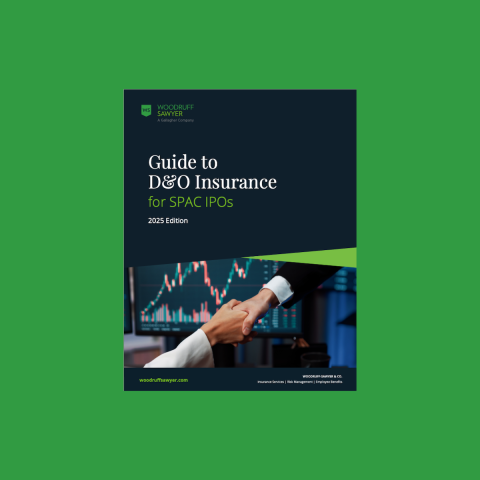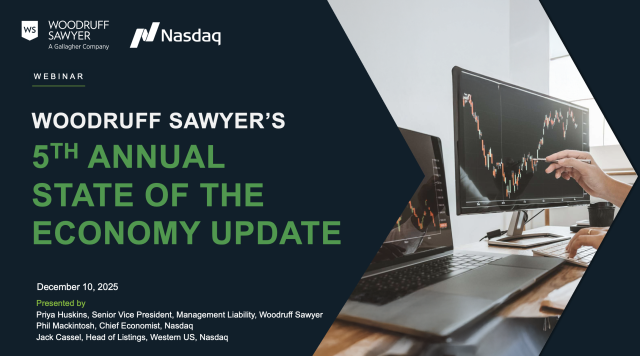Guide
The 2025 Guide to D&O Insurance for SPAC IPOs
After a long cooling-off period, SPAC IPOs are making a comeback. This is encouraging for companies seeking an efficient, flexible route to the public markets.
Having said that, special purpose acquisition companies (SPACs) continue to have unique challenges when it comes to litigation and regulatory scrutiny.
The good news is that lessons learned over the past few years have led to better-structured de-SPAC deals, more rigorous disclosures, and stronger corporate governance—factors that should lead to better outcomes for today’s SPACs and make them more resilient in the face of risk.
Importantly, the directors and officers (D&O) insurance market for SPACs has evolved as well. For those considering a SPAC IPO, it is now possible to secure more cost-effective D&O coverage, provided they understand the risks and prepare accordingly.
The 2025 edition of Woodruff Sawyer’s annual Guide to D&O Insurance for SPAC IPOs offers timely, practical insights for teams navigating this next wave of SPAC activity.
Get instant access to the report now or keep reading for highlights of what’s inside.
Common Risks in the SPAC Lifecycle
Litigation and regulatory risks for SPACs are real. Understanding where the greatest exposures lie can make a material difference in protecting directors, officers, and shareholders.
Litigation Trends
While the types of lawsuits facing SPACs continue to evolve, several patterns have emerged:
- Merger objection lawsuits: Usually filed immediately after a deal is announced, these suits typically allege insufficient disclosure. Many are resolved quickly with additional disclosure and a mootness fee—a de facto “M&A tax” SPACs should include in their budget.
-
Securities class actions (SCAs): These more serious lawsuits can target the SPAC, its officers, its board, its sponsor, and the target company. Allegations usually center on material misstatements or omissions and can arise even before a merger closes. The good news is that SCAs are significantly down from years prior.
- Breach of fiduciary duty claims: Plaintiffs’ attorneys have largely shifted from SCAs to filing fiduciary duty suits in Delaware. When a court determines that the “entire fairness” standard applies to SPAC-related fiduciary duty claims, these lawsuits become extremely difficult to dismiss early. Conflicts of interest between sponsors and shareholders remain a core theme.
- Shareholder derivative suits: Filed on behalf of the SPAC, these suits often follow a securities class action and allege harm to the corporation by its directors and officers. Notably, Delaware corporations cannot indemnify derivative suit settlements, making robust Side A D&O insurance especially critical.
- Creative and novel theories: Plaintiffs’ lawyers continue to explore new angles of attack, from termination fee cases to technical disputes over shareholder voting.
Given the risks associated with some of these lawsuits, more SPACs are choosing to incorporate in the Cayman Islands—a move that can work in their favor when it comes to securing D&O insurance, as we'll explore later in this article.
It’s important to note that the likelihood of being sued varies. As we recently shared:
- About 17% of de-SPACs were sued in 2024, compared to approximately 13% of new traditional IPO companies and about 3% of mature public companies.
- Companies merging with a SPAC have been consistently more likely to face an SCA than those going public via a traditional IPO.
In other words, companies going public via a traditional IPO are already more prone to lawsuits than their mature counterparts, and companies that go public via a SPAC face an even higher risk of being sued.
Regulatory Enforcements
Litigation isn’t the only threat. Agencies like the Securities and Exchange Commission (SEC), the Department of Justice, and the Financial Industry Regulatory Authority (FINRA) are actively policing SPAC transactions.
In addition, enforcement actions have expanded in recent years beyond the SPAC sponsors and targets to include advisers, underwriters, and others involved in the transaction process.
Cases like Momentus/Stable Road and Nikola demonstrate how costly regulatory investigations can be, with settlements reaching the tens or hundreds of millions.
With the massive wave of SPAC mergers completed in 2021 and 2022, and given the typical nine-month lag before lawsuits are filed, the industry should expect continued litigation and enforcement activity well into 2025.
Good News: D&O Insurance Costs Are More Manageable
Despite ongoing risks, the good news for SPAC IPOs is that securing D&O insurance has become significantly more manageable. Careful planning is essential to take full advantage of today's improved conditions.
Premiums Are Down
It’s unsurprising that during the SPAC boom of 2020–2021 and the subsequent rush of litigation, D&O insurance premiums for SPAC IPOs reached historically high levels.
Thankfully, the market has shifted. Starting in mid-2022 and continuing into 2025, premium costs for SPAC IPOs declined sharply.
One factor driving this trend is the re-entry of insurance carriers into the SPAC D&O market. Importantly, however, underwriters continue to scrutinize SPAC submissions closely. Appetite can vary significantly based on various factors, which we’ll discuss later.
Why Early Engagement Matters
Engaging with a knowledgeable broker early in the SPAC formation process—ideally before your confidential Form S-1 filing—is key.
Doing so ensures you’ll have time to explore strategic options for structuring the insurance program, negotiating better terms, and, where possible, reducing costs for the IPO and the post-merger public entity.
Companies that treat D&O insurance placement as a strategic priority rather than a last-minute compliance task are best poised to secure the protection they need at a good price point.
What Insurers Look for When Offering Coverage
While D&O insurance for SPAC IPOs is more accessible today, insurers remain selective. Companies that understand the underwriting litmus test—and prepare accordingly—will have an edge.
When evaluating SPACs, insurers typically focus on several key factors:
- Sponsor team experience. Underwriters favor teams with prior SPAC success, public company leadership, M&A know-how, and strong industry expertise. Inexperienced teams may face higher premiums and tighter terms.
- Jurisdiction of incorporation. SPACs based in the Cayman Islands are generally viewed more favorably than those incorporated in Delaware. This is, of course, the result of recent Delaware Chancery Court rulings that have made Delaware SPACs riskier to underwrite.
- Capital raised in the IPO: Larger offerings are seen as riskier from a claims perspective, which can lead to higher D&O premiums.
- Redemption mitigation plans. Insurers expect a credible strategy to address high shareholder redemptions, which can threaten deal viability and increase exposure.
- Length of investment period. SPACs with very short timelines (e.g., 15 to 18 months) are seen as riskier, particularly in a market where sourcing and closing deals are increasingly complex.
Get the Full Guide to Learn More
SPACs may be regaining momentum, but the risks are still complex. Companies that have the right insurance strategy in place from day one are better equipped to handle scrutiny and move forward with confidence.
That’s where Woodruff Sawyer’s 2025 Guide to D&O Insurance for SPAC IPOs can help. Inside, you’ll find practical guidance on how to navigate the SPAC insurance lifecycle with key milestones on the road to going public.
The Guide covers the topics in this article in more detail, and also includes:
- How to structure your D&O insurance program from the ground up, including timing your placement.
- Strategies for negotiating total policy limits, balancing ABC coverage and Side A-only options.
- Best practices for minimizing self-insured retentions (deductibles) and securing favorable premium terms.
- How to handle the "tail policy" (runoff coverage) when your business combination closes.
- Insurance diligence tips for evaluating your SPAC's merger target, and why gaps in the target’s insurance program matter.
- How to manage shareholder lawsuits and regulatory investigations at the time of deal announcement, including claims handling and defense counsel selection.
- How reps & warranties insurance (RWI) can protect your deal.
- D&O insurance considerations for the post-merger public company.
- Key questions to ask when choosing your D&O insurance broker, and the mistakes to avoid.
Get the full Guide now to learn more.
Authors
Table of Contents














